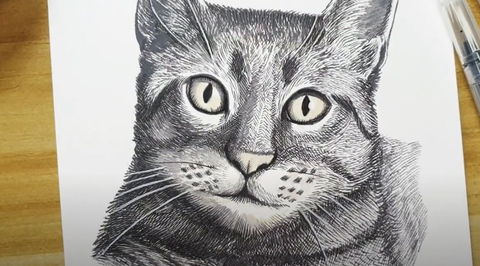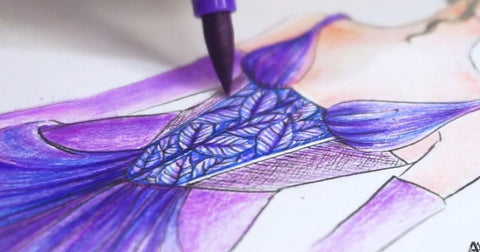Watercoloring Tips to Achieve Realistic Skin Tones
Last Updated: July 29, 2024
"Watercolor is a medium that can be as demanding and temperamental as those who choose to paint with it. But it is a colorful and exciting medium all the same – well suited to describing the many moods of the subject, as well as those of the artist wielding the brush." - Jean Burman.

Best Watercoloring Supplies for Artists
Have you ever struggled with creating realistic skin tones in your watercolor paintings? It can be a daunting task, but with the right techniques and practice, it's possible to achieve a natural and lifelike effect. As an artist, it's essential to master this skill, as it opens up a world of possibilities to create compelling portraits and figures that evoke emotion and capture the essence of the human spirit.
For today’s blog post, we will discuss the importance of achieving realistic skin tones in watercolor paintings and will provide you with some valuable tips to help you achieve this goal. By honing your craft and developing your own unique style, you can create soulful and authentic projects that truly reflect who you are as an artist. So whether you're a beginner or an experienced painter looking to expand your skills, we're here to help you on your journey to creating stunning and realistic watercolor portraits!
Understanding the Principles of Skin Tone in Watercoloring
When watercoloring realistic skin tones, understanding the diversity of skin tones and accurately representing them in color is essential. Skin comes in a vast array of hues, shades, and undertones, each unique and beautiful in its own way. As an artist, we are responsible for capturing this diversity and celebrating it through watercolors! If you need some tips on how to portray and learn how to paint skin tones, read the following:
Study Lighting, Shadows, and Undertones
To achieve a realistic depiction of skin, it's crucial to understand the impact of lighting, shadows, and undertones. Light plays a transformative role in how we perceive skin, casting highlights and shadows that add depth and dimension.
The way light interacts with skin can create an interplay of warm and cool tones, bringing out the subtle undertones that make each complexion unique. For example, a fair complexion may have cool blue or pink undertones, while a darker complexion may have warm undertones of red or gold.

Watercolor Paper Pad (9"x 12")
Shadows, on the other hand, can add depth and create a sense of realism. They provide contour and structure to the face, emphasizing the bone structure and adding definition to features. By understanding how light and shadows interact with skin, you can create more lifelike and believable representations. You can do this by constantly observing the people around you, getting a real-life model in a controlled light setting, or replicating the techniques done by your favorite artist via Youtube videos or social media posts.
Exploring the impact of lighting, shadows, and undertones allows you to delve into the complexities of skin and create compelling and authentic portrayals. It enables you to capture the subtle nuances and intricacies that make each individual's skin unique and tells a story beyond what meets the eye. You can capture this by making a sketch of the portrait, determining where your light source is and what parts of the portrait should be darker or lighter.
Build Depth and Gradation With Layering and Glazing
Layering and glazing techniques are crucial for achieving realistic skin tones. By building layers of transparent washes, artists can gradually build up depth and color intensity. Start with lighter washes and gradually add darker tones, allowing each layer to dry before applying the next. This method creates a smooth transition of colors, mimicking the natural gradients found in the skin.

Artists' Watercolor Brushes - Round
Glazing, on the other hand, involves applying thin, transparent washes of color over dry layers. This technique adds richness and depth to the skin, enhancing the subtle variations of color and creating a sense of luminosity.
Gain a Good Understanding of Color Mixing

Behind the canvas of a great painting is an even greater color-mixing technique. Color mixing is fundamental in watercolor painting, particularly when it comes to painting portraits. Understanding how colors interact and blend is essential for achieving the right hues and undertones. You can do this by working with the watercolor paint that you have and creating a normal color swatch and a color mixing swatch, which you can refer to as a guide again and again for all your artwork.
Observe and Capture Highlights and Shadows
Pay attention to the interplay between light and shadows, and use different techniques to capture their effects. You can leave areas of the paper unpainted to represent highlights while using deeper tones and layered washes to depict shadows. This contrast adds depth and perspective to your paintings, giving your portraits more of a 3D look than just a one-dimensional design.

Add Textures for a More Realistic Depiction of Skin
Human skin is not perfectly smooth but contains subtle textures and details that make it unique. To capture these textures, you can experiment with various watercolor techniques, such as dry brushing, splattering, or using a toothbrush to create speckles. These techniques can mimic freckles, pores, or fine lines that give character to skin.

Don't be afraid to add small details such as eyelashes, eyebrow hairs, or tiny blemishes with extra fine brushes, twigs, or other tools to help create small lines. These seemingly minor elements can bring your watercolor portraits to life and add a touch of realism!
Create Stunning Portraits With Skin Tones Using These Tips!
By mastering these watercolor techniques, you can confidently portray realistic skin tones that capture the essence and individuality of your subjects. Remember, practice and experimentation are key to mastering these techniques. Embrace the journey of continuous learning and allow your creativity to soar as you delve into the captivating world of realistic watercolor skin tones!
If you want to read more watercolor painting tips like these, try checking out our article on 5 Must-Try Watercolor Techniques For Your Next Projects! There is always unlimited inspiration at the Creative Corner for you to enjoy. Happy painting!






